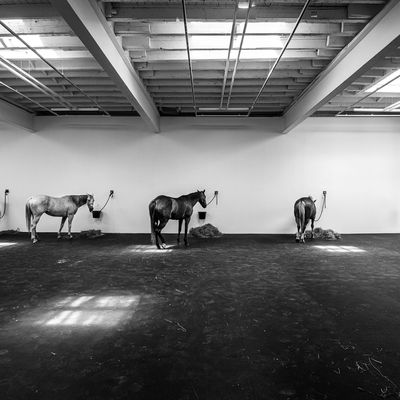
For all their faults, flaws, weirdness, and self-aggrandizement, all art galleries are gifts to us all. They are free and open to the public, for anyone, just not for everyone, places to have conclaves, conversations, conversion experiences, and holy-shit recognitions. Right now, one of New York’s galleries is bestowing a gift to all art lovers. Between now and 6 p.m. Saturday, when Gavin Brown Gallery closes its doors for the last time at its magical no-man’s location between Soho, the Hudson River, and West Chelsea, the gallery is restaging one of the most iconic works of 1960s Conceptualism/Arte Povera/performance and installation art: Jannis Kounellis’s Untitled (12 Horses).
Brown’s large west gallery is emptied of everything except a quieting, supple, rubberized floor. Tethered to walls are 12 horses. Far from being yet another example of the revival of this or that work of 1960s or 1970s art — a trope that has become depressingly familiar in today’s art world always on the lookout for some niche of recent art history that needs marketing — the sight of these immense animal presences in an art gallery comes on with almost metaphysical force. For me, horses are an other otherness, a higher order of it. Creatures that tranquilize my responses, awe me, make me know a manifest uncanniness of identity. I love and fear them in ways I can’t fathom. Whatever they are, their presence in an art gallery — peaceful, delicate, humbling — is something we don’t know we need to know until we know them, and then are grateful for knowing. This is an apt metaphor for what art galleries can do.
The horses are handsome, not the draught horses used in the original, which was staged in 1969 in an underground Italian garage with a hard tiled floor. Nor are they the broken animals we were used to seeing about Central Park. Poised, quiet, calm, they stand at three of the gallery’s four walls, eating hay from buckets attached to the wall, neighing occasionally, rustling, relieving themselves. They are attended to at all times by three loving grooms. The room has a reverence, not for a work of art but for life, and the ways it can embed itself in things we call art. It’s a crazy love, this albumen of the mind that is impregnated with thoughts of something being more or other or different than what it is, magic, elemental, us, not us.
In many ways, what’s going on in Brown’s space is what’s going on in all art galleries all the time, for someone, somewhere. Someone is sliding away from hard reality to some other destination, a place that is just as real, sometimes more so than the reality they’re in. Brown is part of a great generation of dealers who opened galleries in the 1990s, people whose purpose was to somehow to make money while making worlds possible where they, and the kind of art that they thought helped people, slide into these other destinations. Alongside the Kounellis show at Brown’s gallery is an installation by Rirkrit Tiravanija wherein the artist has removed the doors and windows from the gallery, leaving the space open 24 hours a day. Before 6 p.m., food is cooked and served for free. Then, at sundown until daybreak, the gallery screens Elaine Sturtevant’s iconic film Empire, itself an incubus inhabitation-possession of Andy Warhol’s film of the Empire State Building. I’m already seeing all-night pictures on Instagram of people hanging out watching the film.
By itself, the work stills the spirit and lifts the senses. Adding to that, the gallery hasn’t really publicized this in any way. It’s more for the odd, extended, amorphous family of the art world. This isn’t a Kusama-effect situation, where lines of people wait to walk into the space, take a selfie, and leave after hashtagging. It’s just for people who may be lucky enough to happen by it or feel a calling to visit. No matter what you think of these three works of art or this gallery’s program, the show is a reminder of just how special and fragile our art world is, how even when seen through laser-lit filters of cynicism, capital, and developers, all of this is temporary and for free.




